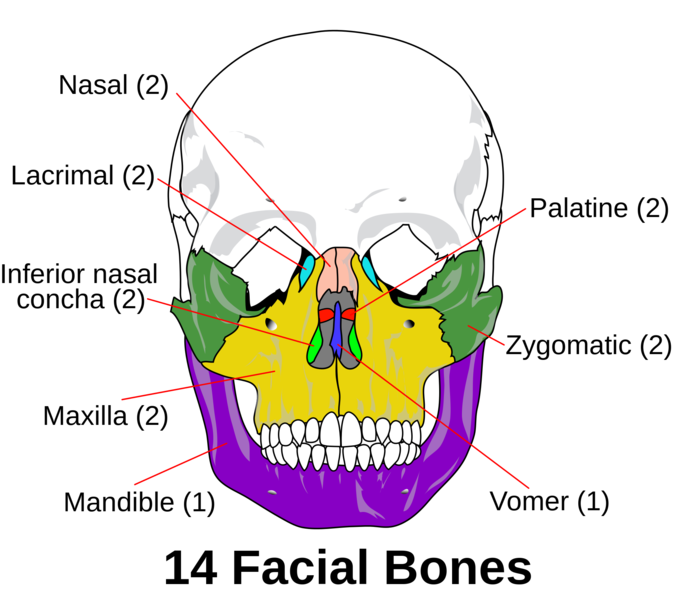7.1A: General Features and Functions of the Skull
- Page ID
- 7476
The human skull is the part of the skeleton that supports the structures of the face and forms a cavity for the brain.
- Describe the parts of the skull
Key Points
- The adult human skull consists of two regions of different embryological origins: the neurocranium and the viscerocranium.
- The neurocranium is a protective shell surrounding the brain and brain stem.
- The viscerocranium (or facial skeleton) is formed by the bones supporting the face.
- Except for the mandible, all skull bones are joined together by sutures —synarthrodial (immovable) joints.
- The skull contains air-filled cavities called sinuses. Their functions are debatable, but may be related to lessening skull weight, contributing to voice resonance, and warming and moistening inspired air.
Key Terms
- viscerocranium: The skeleton that supports facial structure.
- sutures: A fairly rigid joint between bones of the neurocranium.
- neurocranium: The protective vault surrounding the brain and brain stem.
The skull supports the musculature and structures of the face and forms a protective cavity for the brain. The skull is formed of several bones which, with the exception of the mandible, are joined together by sutures—synarthrodial (immovable) joints.
Composition of the Skull
The adult human skull is comprised of twenty-two bones which are divided into two parts of differing embryological origin: the neurocranium and the viscerocranium.
Neurocranium
The neurocranium forms the cranial cavity that surrounds and protects the brain and brainstem. The neurocranium is formed from the occipital bone, two temporal bones, two parietal bones, the sphenoid, ethmoid and frontal bones; they are all joined together with sutures.

Components of neurocranium: Neurocranium consists of 8 parts: frontal, sphenoid, ethmoid, occipital, 2 temporal, and 2 parietal bones.
Viscerocranium
The viscerocranium bones form the anterior and lower regions of the skull and include the mandible, which attaches through the only truly motile joint found in the skull. The facial skeleton contains the vomer, two nasal conchae, two nasal bones, two maxilla, the mandible, two palatine bones, two zygomatic bones, and two lacrimal bones.

Components of viscerocranium : The face is made of 2 nasal, 2 lacrimal, 2 palantine, 2 inferior nasal concha, 2 zygomatic, 2 maxilla, 1 mandible, and 1 vomer.
Other Features
The skull also contains the sinuses. These are air-filled cavities that contribute to lessening the weight of the skull with a minimal reduction in strength. They contribute to resonance of the voice and assist in the warming and moistening of air inhaled via the nose.

